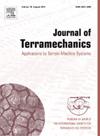DEM-based analysis and optimization of an excavation bucket drum for in-situ resource utilization
IF 3.7
3区 工程技术
Q3 ENGINEERING, ENVIRONMENTAL
引用次数: 0
Abstract
The bucket drum, a cylindrical rotating mechanism that efficiently excavates and collects lunar regolith, is essential for in-situ resource utilization (ISRU). While bucket drums offer advantages in energy efficiency and adaptability to low-gravity conditions, optimizing their shape and motion remains an open issue. Therefore, this paper aims to find an optimal design of the bucket drum using the discrete element method (DEM). We focus on five key design parameters were analyzed: two related to bucket shape (scoop throat length and scoop inlet number) and three related to motion (bucket vertical force, horizontal velocity, and angular velocity). These parameters were evaluated based on two performance indices: sand fill ratio and excavation power consumption. By solving the multi-objective problem of maximizing fill ratio while minimizing power consumption, an optimal design of the bucket drum was identified. Subsequently, a bucket drum with the optimal shape was 3D-printed, and the optimal motion of the bucket drum was applied using the soil excavation test apparatus. The test results qualitatively matched the results derived from the DEM analysis. This highlights the validity of the relationship between the design parameters and two performance indices, contributing to the advancement of ISRU excavation technologies.
基于dem的挖掘斗鼓就地资源利用分析与优化
桶形滚筒是高效挖掘和收集月球风化层的圆柱形旋转机构,是原位资源利用(ISRU)的重要组成部分。虽然斗式鼓在节能和适应低重力条件方面具有优势,但优化其形状和运动仍然是一个悬而未决的问题。因此,本文旨在利用离散元法(DEM)寻找铲斗滚筒的优化设计方法。我们重点分析了五个关键设计参数:两个与铲斗形状有关(铲斗喉部长度和铲斗入口数量),三个与运动有关(铲斗垂直力、水平速度和角速度)。根据填砂比和开挖能耗两个性能指标对这些参数进行了评价。通过求解最大填充率和最小功耗的多目标问题,确定了铲斗滚筒的优化设计方案。随后,3d打印出最优形状的斗鼓,并在土掘试验装置上应用最优斗鼓运动。测试结果与DEM分析结果定性匹配。这突出了设计参数与两个性能指标之间关系的有效性,有助于ISRU挖掘技术的进步。
本文章由计算机程序翻译,如有差异,请以英文原文为准。
求助全文
约1分钟内获得全文
求助全文
来源期刊

Journal of Terramechanics
工程技术-工程:环境
CiteScore
5.90
自引率
8.30%
发文量
33
审稿时长
15.3 weeks
期刊介绍:
The Journal of Terramechanics is primarily devoted to scientific articles concerned with research, design, and equipment utilization in the field of terramechanics.
The Journal of Terramechanics is the leading international journal serving the multidisciplinary global off-road vehicle and soil working machinery industries, and related user community, governmental agencies and universities.
The Journal of Terramechanics provides a forum for those involved in research, development, design, innovation, testing, application and utilization of off-road vehicles and soil working machinery, and their sub-systems and components. The Journal presents a cross-section of technical papers, reviews, comments and discussions, and serves as a medium for recording recent progress in the field.
 求助内容:
求助内容: 应助结果提醒方式:
应助结果提醒方式:


